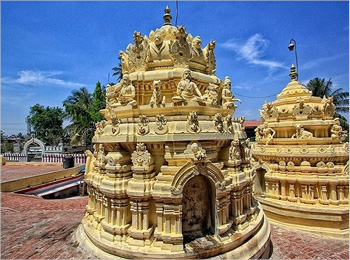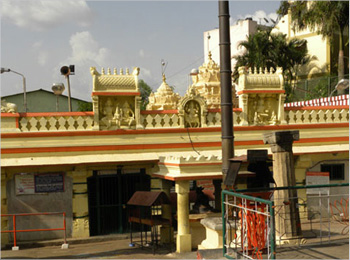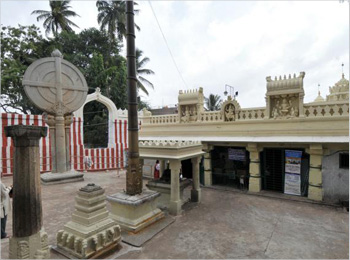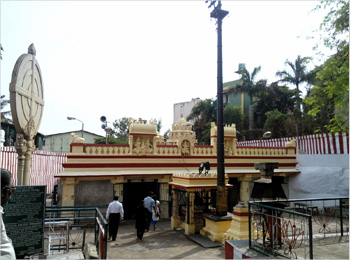- Shiva
Gavipuram Cave Temple
- Karnataka
- View on map
- Tell us about this temple
Overview
The Gavi Gangadhareshwara Temple is situated in Bangalore. The temple is famous for its mysterious stone discs which involves great construction planning that allows the sun to shine at certain parts of the year.
About the temple

This temple is dedicated to Shiva in Bengaluru is a most visited temple. Built in the 16th century AD by Kempe Gowda, the founder of Bengaluru, Temple Gavi Gangadhareshwara is an architectural marvel that attracts the faithful by the hordes. One of the oldest temples in Bengaluru, Gavi Gangadhareshwara temple was built by Kempe Gowda in recognition after being released from prison of five years by Rama Raya. There are other idols inside idol Agnimurthi including having two heads, seven hands and three legs. Those who worship this deity believe will cure one of the defects of the eye. The temple is also known for its four monolithic pillars, representing Damaru, Trishul and two devotees on the patio. Built in a natural cave in Gavipuram, the temple is dedicated to Lord Shiva and cut into a monolithic stone. The courtyard of the temple here contains several monolithic sculptures. The main attractions of Gavi Gangadhareshvara temple are two granite pillars that support the giant disk of the sun and moon, while the other two have a number of Nandi at the top. The Gavipuram Cave Temple is an architectural wonder in itself. The temple was cut out from a natural monolith rock. The inner sanctum of the temple is situated inside a cave carved out in the rock. The main attraction of the temple is the granite pillars situated in the forecourt of the temple. Two of the pillars support huge discs that represent the sun and the moon. The other two pillars have a trident (trishul) and a two-headed drum (damru), representing the two significant possessions of Lord Shiva. But the main architectural significance associated with the temple is the creation of the cave temple and the placement of the stone discs in such a manner that they allow the sun to illuminate the Shivalinga for just one hour every year.
About the Deity

The inner sanctum of the temple has a tall Shivalinga. Another major attraction of the temple is the presence of a rare idol of Agni, the God of fire. The figure has two heads, seven hands and three legs. It is perhaps the only temple in South India that has such an idol. The temple has a wonderful sculpture of Nandi (a bull), Shiva’s mount. A beautiful image of Shakti Ganapathi with 12 hands adorns the left side of the main entrance to the temple.
Legend and stories
.

The history of the temple dates back to the 9th century. It is believed that the temple was cut out of a rock in the 9th century. It was used by the great sage Gowthama to perform penance. Later in the 16th century, Kempegowda I, the founder of Bangalore, revamped and extended the temple. According to local legend, Kempegowda was imprisoned by Rama Raya. He suffered imprisonment for five years. When he was released, he constructed this temple to show his gratitude. Artistic depiction of the temple is found in the painting of the British artist James Hunter in 1792.
Festivals
Thousands of devotees come in mid-January every year on Makar Sankranti Day to this cave temple. This is a special day when the sunrays fall on the Sivalinga for one hour as it passes between the horns of the Nandi. Such was the knowledge of architecture and astronomy that the ancient sculptors could craft the horns of the stone bull outside the temple so that the sun's rays would pass through its horns and light up the deity Shiva Linga inside the cave. Comparison of contemporary structures and earlier drawings by Thomas Daniel and William Daniel show that earlier the temple has less structures and the Sun illuminated the shrine in summer and winter solstice. Also today the Sun illuminates Shivalinga two times per year - from 13 to 16 January in late afternoons and from 26 November to 2 December.
Rare Facts/Interesting facts
There are lots of beliefs and myths associated with the temple. It is believed that anyone who worships the idol of Agni (the God of fire) situated inside the temple will be cured of all eye defects. Devotees also believe that there are two tunnels that extend from the inner sanctum of the temple. One of them proceeds towards the city of Varanasi in the northern part of India. The other extends up to another temple of Shiva with the same name, the Gangadhareshwara temple, located on the hill of Shivagange, about 10 miles from this temple.
Significance
Every year, on the 14th of January, there is a rare and significant phenomenon that takes place in the inner sanctum of the temple. The rays of the setting sun on the western horizon shoot a beam of light that passes from under an arch on the western wall of the temple before moving towards the inner sanctum. It first lights the back of the statue of Nandi and passes over its horns and reaches the feet of the Shivalingam. Finally the beam of light illuminates the body of the Shivalingam. This is a wonderful sight as the event is marked by continuous ringing of the bells and chanting of mantras by the priests and devotees. The lingam is bathed in milk by one of the priests during the entire period of the phenomenon. It seems as if the Sun is showing reverence of the Lord on the auspicious day.
Accessibility
Air
The international airport at Bangalore connects the city to other major cities within and outside the country.Rail
The railway station at Bangalore has many trains operating out of it and linking the city to all other parts of the country.Road
There are local buses, taxis and auto-rickshaws that can be hired to reach the Gavi Gangadhareshwara temple from any part of Bangalore.Address
The Gavi Gangadhareswara Temple,
Bangalore, Karnataka
Significance
Devotees visit this temple to seek fulfillment of the following:-
- To be relieved of eye-related ailments
Shlokas
Kailaasarana Shiva Chandramouli Phaneendra Maathaa Mukutee Zalaalee Kaarunya Sindhu Bhava Dukha Haaree Thujaveena Shambho Maja Kona Taaree
Meaning -Oh Lord Shiva who is seated on Mount Kailash, where the moon decorates his forehead and the king of serpents crown his head, who is merciful and removes delusion, You alone can protect me. I surrender to thee.
Aum Trayambakam Yajaamahey Sugandhim Pusti Vardhanam Urvaarukamiva Bandhanaath Mrutyor Muksheeya Maamritaat
Meaning -We worship the fragrant Lord Shiva, who has 3 eyes and who cultivates all beings. May He free me from death, for immortality, as even a cucumber is separated from its bond with the vine.
Timings
Monday - Friday: 6.00 AM - 8.00 PM
Saturday: 6.00 AM - 8.00 PM
Sunday: 6.00 AM - 8.00 PM
Public Holidays: 6.00 AM - 8.00 PM
